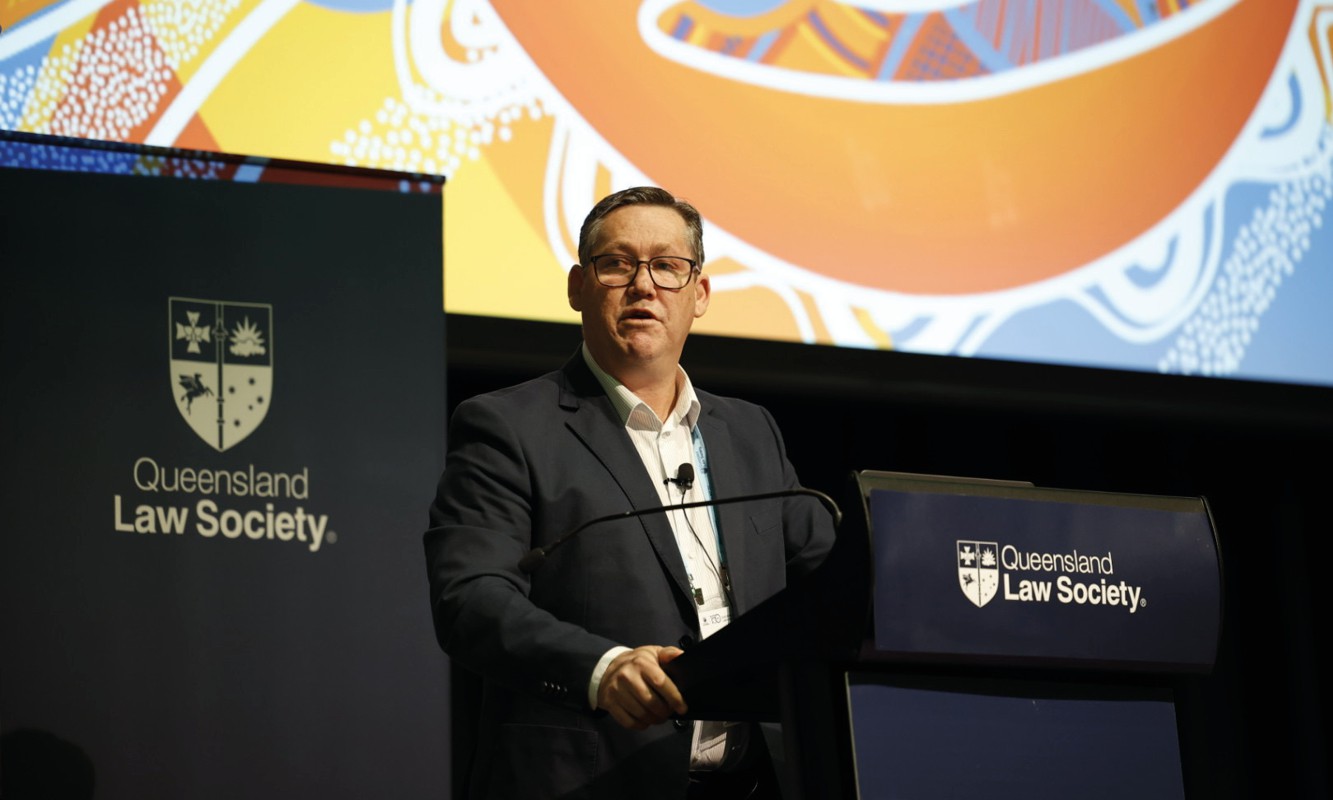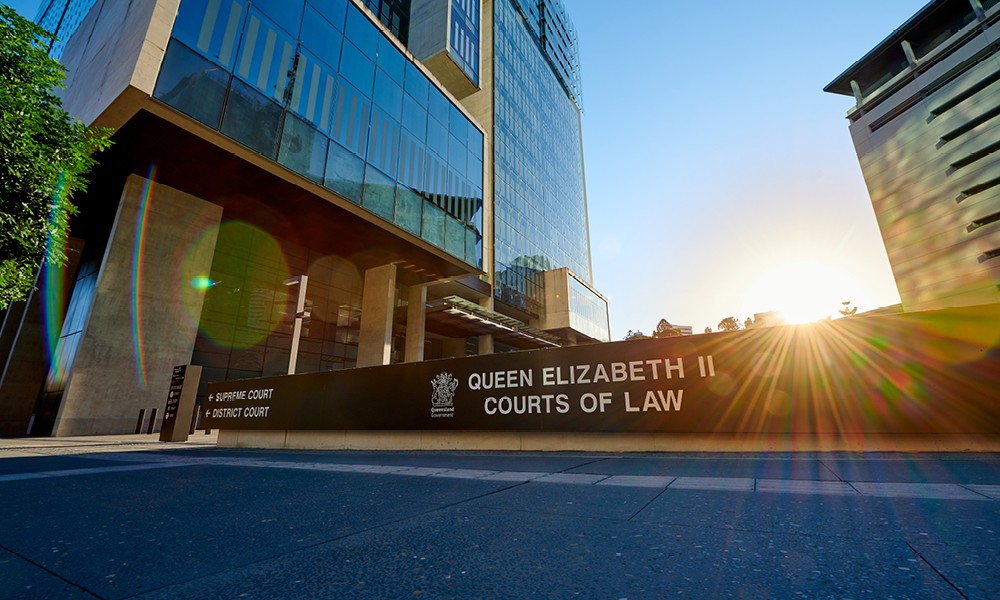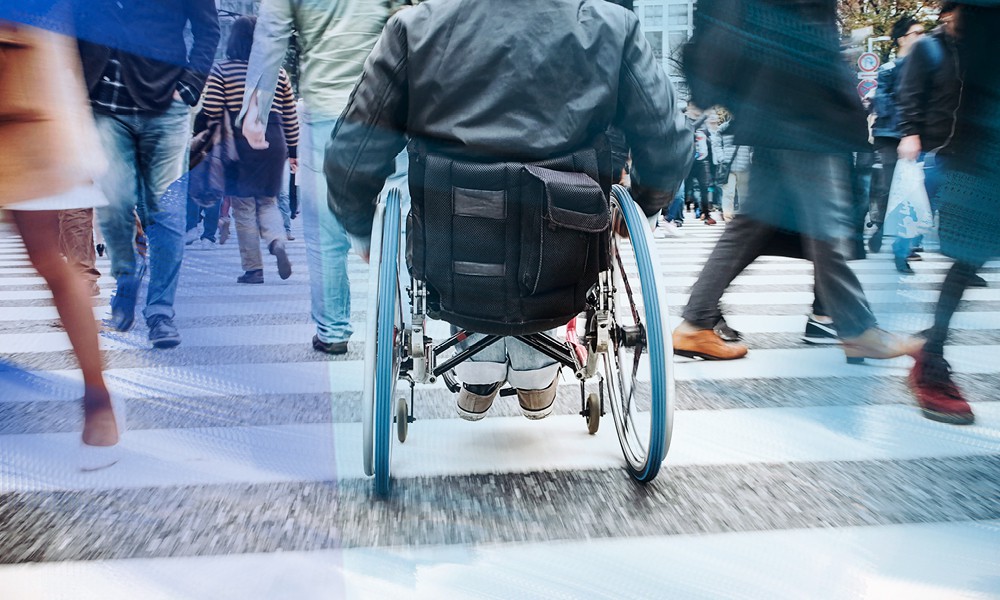The use of restrictive practices in Australia is often hidden, but they are applied routinely in many settings. The Australian Law Reform Commission considers the use of restrictive practices to be a key human rights challenge for Australia and has recommended legislative reform. It is critical that restrictive practices are applied legally, their use is governed by established principles, and is closely regulated to protect the rights, safety and wellbeing of vulnerable people who are subject to these practices.
The images we normally associate with restrictive practices involve people detained in institutionalised settings such as prisons or mental health units being physically restrained or isolated from others in locked rooms or cells.
The reality is that restrictive practices are used across a range of institutional care settings and services to manage challenging behaviours and anticipated risks, from residential aged care, mental health facilities and prisons, to disability service settings, supported accommodation, in hospitals and health facilities, and in schools and other educational institutions. In most of these settings, the legality of the use of the restrictive practices is questionable at best and potentially criminal, at worst.
The definition of restrictive practice includes ‘any practice or intervention that has the effect of restricting the rights or freedom of movement of a person with disability, with the primary purpose of protecting the person or others from harm’.[1] Restrictive practices can include, detention, seclusion, physical, chemical and mechanical restraint, as well as electronic forms of restraint such as tracking bracelets, camera surveillance or restrictions on access to media devices or other objects. Of particular recent interest has been the use of chemical restraint. Chemical restraint refers to the use of medication that is given primarily to control a person’s behaviour, rather than to treat a mental illness or physical condition.
Currently, there is no comprehensive or uniform legal framework that regulates the use of restrictive practices across settings and areas of life in Australia.[2] When it occurs outside of a formal legislative framework, and cannot be justified by the defence of emergency, the physical or chemical restraint, detention or seclusion of a person can constitute a criminal act, such as assault, deprivation of liberty, or the unlawful administration of medical treatment, including prescription drugs.[3]
The human rights outlined in the United Nations Convention of the Rights of Persons with Disabilities (CRPD)engaged by the use of restrictive practices include, the right to equal recognition before the law,[4] to liberty and security,[5] freedom from torture or cruel, inhuman or degrading treatment or punishment,[6] freedom from exploitation, violence and abuse,[7]
The use of restrictive practices also engages a series of rights in the Human Rights Act (Qld) 2019, including the right to;
- Protection from torture, cruel or inhuman treatment;[8]
- Freedom of movement;[9]
- Privacy and reputation;[10]
- Liberty and security of person.[11]
Recent revelations from the Royal Commissions about the use of restrictive practices in the aged and disability sectors have demonstrated the terrible impact they can have on the quality of life, and psychological and mental health and wellbeing of those who are subject to this treatment.
It is important for us all to remember that this treatment occurs routinely in institutional settings. Many reading this article will have first-hand experience of a family member in an aged care facility being restrained in a chair or administered medication to sedate them or manage behaviours that arise from their distress at being removed from their own home. Or we may have children or grandchildren with disability who have challenging behaviours that are not being appropriately managed in educational settings and their rights are being violated. Invariably restrictive practices are used on people who are very vulnerable and, more often than not, without the consent of the person or their legal decision-maker.
We also need to acknowledge that we are all ageing and that it is very likely that we will all become one of those older people who require assistance to live, so it is in all of our interests to ensure we have a comprehensive legal framework that clearly outlines the circumstances in which restrictive practices can be lawfully used (more about that later). Without proper regulation, recording, reporting, training and oversight the risk of serious or tragic outcomes from using restrictive practices increases.
Notable cases and inquests associated with the use of restrictive practices in Australia include;
- Skyllas v Retirement Care Australia (Preston) Pty Ltd,[12] in which the Victorian Supreme Court invoked the writ of habeas corpus against a residential aged care facility, finding that it is unlawful for such a facility to detain a resident against their will, regardless of their physical health.
- Saitta Pty Ltd v Secretary, Department of Health and Ageing,[13] in which the Administrative Appeals Tribunal upheld the Department of Health and Ageing’s imposition of severe sanctions that led to the closure of an aged care facility in Melbourne following an assessment that residents’ safety was at severe and immediate risk. The tribunal described an incident where an unattended resident had been restrained in a chair with a lap-belt an hour after it should have been removed. This was considered a breach of the principles providing for the residents’ right to dignity, to be assisted to achieve maximum independence, and for management to actively work in providing a safe and comfortable environment consistent with the residents’ needs.
- Findings of the Inquest into the death of Taare Tamakehu Rangi,[14] in which the Coroner found the deceased died in an authorised mental health service following being physically restrained to administer medication, during which he suffered a cardiac arrhythmia. The Coroner found it had not been necessary to administer the medication to the deceased at that time. He was not agitated, or threatening violence, nor was he a danger to himself of others. The Coroner also found the decision to administer medication under restraint was a ‘serious and fundamental error of judgement’ on the part of the responsible member of the treating team. The case was referred to the Director of Public Prosecutions on the basis that the restraint procedure, including the pinning of the deceased’s head to the ground by a knee, followed by a neck restraint, was not taught or sanctioned by the Hospital and Health Service and gave rise to a reasonable suspicion that an offence had been committed and that the neck restraint was a substantial or significant cause of death.
As already noted, the use of restrictive practices has been a focus of the Royal Commission into Aged Care Quality and Safety and the Royal Commission into Violence, Neglect, Abuse and Exploitation of People with Disability. Both Commissions have heard about how restrictive practices are used to manage behaviours, often in response to a lack of funding that limits the level of engagement staff in the aged and disability sectors can have with residents. The use of chemical restraint is a harsh substitute for the time, care and respect that vulnerable people need.
Often, the very behaviour that is being ‘managed’ by the use of restrictive practices can be exacerbated by the restraint employed. For example, restrictive practices, including chemical restraint, are often used in nursing homes to reduce the risk of residents experiencing falls when they are known to ‘wander’ around the facility. However, the use of chemical restraint actually increases the risk of a resident suffering from a fall, as there is a direct correlation between the use of psychotropic drugs as a form of chemical restraint and fall risks.[15]
Commissioners from the Royal Commission into Aged Care Quality and Safety stated that;
The Royal Commission’s inquiry has revealed instances where the use of restrictive practices in aged care has been inhumane, abusive and unjustified. Restraining a person, whether through physical or pharmacological means, is dehumanising and disempowering. It is an affront to dignity and personal autonomy. The overwhelming weight of evidence confirms that restrictive practices have questionable success in minimising so-called ‘challenging behaviours’. They also carry risks of serious physical and psychological harm, including health complications and premature death.[16]
Evidence presented at the Royal Commission into Violence, Abuse, Neglect and Exploitation of People with Disability has told a similar story;[17]
Submissions from parents of students with disability describe the use of seclusion and physical and chemical restraints in schools.[18] One parent described how a teacher physically held their child down, injuring the child.[19]
We have also heard about the use of restrictive practices in group homes. One submission from an advocate for people with disability described the use of physical restraints:
DMC was tied up with a bungy cord to keep him seated in a chair tied to the kitchen table so that he was forced to sit at the table for 8 hours or more, only getting up from the table for a bathroom break a couple times a day … for years he remained tied to the kitchen chair.[20]
Both Commissions concluded that there is an urgent need for uniform legislation and regulation for restrictive practices, across jurisdictions and settings, underpinned by key human rights principles.
Regulation of restrictive practices should be underpinned by a consistent set of principles that are aligned with Australia’s human rights obligations, respecting and supporting people’s dignity and personal autonomy while providing clarity about the circumstances in which care or treatment including restrictive practices may be authorised by another person.[21]
All States and territories have laws, policies and standards for the use of restrictive practices but there is no uniform regulatory framework across all jurisdictions and settings. We have received information about the use of restrictive practices in educational, residential, health and detention settings, including the use of:
- seclusion and physical and chemical restraints in schools
- physical and environmental restraints in group homes
- physical, chemical and mechanical restraints in health facilities
- seclusion and chemical restraints in detention settings. [22]
Queensland has a comprehensive legislative framework for use of restrictive practices in disability service settings, which only permits restrictive practices to be used in conjunction with a model of positive behaviour support. Positive behaviour support requires multi-disciplinary assessments of the person who may be subject to a restrictive practice and their care and support needs and the development of a positive behaviour support plan with the object being to use the least restrictive option applied for the shortest period necessary with a view to reducing the use of restrictive practices over time. The Queensland framework now interacts with monitoring and oversight processes introduced by the National Disability Insurance Scheme (NDIS) for participants.
The Queensland restrictive practices regime is authorised under chapter 5B of the Guardianship and Administration Act 2000. Any person or entity that exercises a power or function in relation to restrictive practices must apply the general principles of the Guardianship and Administration Act 2000, as well as the human rights principles under the Human Rights Act 2019 and comply with the other requirements of the Disability Services Act 2006.[23]
While the regime provides for protections and safeguards for Queenslanders receiving disability services, it is limited in its application to the disability services sector. The scheme is also complex to navigate and resource intensive for service providers. There are also inconsistencies between the State and NDIS definitions about what constitutes a restrictive practice, creating confusion for service providers and the risk of non-compliance with authorisation and reporting processes.
Restrictive practice are also routinely used in hospital settings to manage the challenging behaviours of patients who may be affected by drugs, have mental illness or disability and who are distressed by their illness, the unfamiliar surroundings of the hospital or by the medical procedures or tests being administered. There is currently no legal framework to regulate and oversee the use of restrictive practices in medical settings in Queensland hospitals (except under the Mental Health Act 2016, which requires a diagnosis of a mental illness to use restrictive practices under those provisions). Without a formal legal framework, staff cannot be properly trained in appropriate and approved restraint techniques, policies and procedures for the administration of restrictive practices cannot be developed and patients and staff are at risk of unlawful treatment and the prospect of criminal prosecution, respectively.
Going forward, we need a single clear, enforceable legal framework to authorise and regulate the appropriate use of restrictive practices across all care and detention settings, that will provide for a nationally consistent approach to this challenging human rights issue. Such a legal framework needs to be supported by formal reporting and oversight mechanisms that; set thresholds for the use of restrictive practices, prescribe standards for their application, and enforce requirements for accountability.
The key principles and characteristics of a new national restrictive practices framework should include:
- Restrictive practices should be regulated by legislation;
- Any restrictive practice should be the least restrictive of the person’s human rights and used only:
- as a last resort, and after alternative strategies have been considered;
- to prevent serious physical harm to the person or another;
- to the extent necessary and proportionate to the risk of harm;
- with the approval of a person authorised by law to make this decision;
- as prescribed by the person’s positive behaviour support plan; and,
- when subject to regular review.[24]
- The importance of maximising the person’s:
- physical, emotional, social and intellectual potential; and
- opportunities for participation in and inclusion in the community;
- The aim/objective of reducing or eliminating the need for the use of restrictive practices; and
- The need for transparency and accountability in the use of restrictive practices.
Additional safeguards should include:
- Establishing an independent Senior Practitioner for aged care, to provide expert leadership on and oversight of the use of restrictive practices across all sectors;
- Requiring the recording and reporting of the use of restrictive practices; and
- Consistently regulating the use of restrictive practices across sectors.[25]
[1] Australian Government, National Framework for Reducing and Eliminating the Use of Restrictive Practices in the Disability Service Sector, (2014) 4 and cited in Australian Law Reform Commission, 2017, Elder Abuse: A National Legal Response, at p 142.
[2] Royal Commission into Violence, Abuse, Neglect and Exploitation of People with Disability, Issues Paper, Restrictive Practices, 26 May 2020, p.4, https://disability.royalcommission.gov.au/system/files/2020-07/Issues-paper-Restrictive-practices.pdf.
[3] Ss 245 and 246 Assault; s 355 Deprivation of liberty; administration of medical treatment without consent can amount to assault or trespass against the person and have legal consequences for the health professionals involved, see Australian Law Reform Commission website at: https://www.alrc.gov.au/publication/equality-capacity-and-disability-in-commonwealth-laws-dp-81/10-review-of-state-and-territory-legislation/informed-consent-to-medical-treatment/ accessed 1 December 2020.
[4] United Nations, Convention on the Rights of Persons with Disabilities, opened for signature 30 March 2007, 999 UNTS 3 (entered into force 3 May 2008), Article 12.
[5] Ibid, Article 14.
[6] Ibid, Article 15.
[7] Ibid, Article 16. Also see United Nations, International Covenant on Civil and Political Rights, Articles 9 and 17.
[8] Human Rights Act 2019 (Qld), s 17
[9] Human Rights Act 2019 (Qld), s 19.
[10] Human Rights Act 2019 (Qld), s 25. The right to privacy also protects the individual against interference with their physical and mental integrity. See Queensland Human Rights Commission website at: https://www.qhrc.qld.gov.au/your-rights/human-rights-law/right-to-privacy-and-reputation#:~:text=It%20also%20extends%20to%20a,’%20or%20’arbitrary’%20interference accessed 1 December 2020.
[11] Human Rights Act 2019 (Qld), s 29.
[12] Skyllas v Retirement Care Australia (Preston) Pty Ltd [2006] VSC 409
[13] Saitta Pty Ltd v Secretary, Department of Health and Ageing (2008) 105 ALD 55
[14] Coroners Court of Queensland, Inquest into the death of Taare Tamakehu Rangi, 2018/3003, 29 June 2020, Cairns
[15] Westbury et al, RedUSe: reducing antipsychotic and benzodiazepine prescribing in residential aged care facilities, Medical Journal of Australia 208 (9), 21 May 2018, 398.
[16] Royal Commission into Aged Care Quality and Safety, Interim Report: Neglect, Volume 1, 31 October 2019, < https://agedcare.royalcommission.gov.au/publications/interim-report-volume-1>.
[17] Royal Commission into Violence, Abuse, Neglect and Exploitation of People with Disability: Interim Report, October 2020, p.338 < https://disability.royalcommission.gov.au/system/files/2020-10/Interim%20Report.pdf>.
[18] For example, Name withheld, Submission, 14 January 2020; Name withheld, Submission, 11 March 2020; Name withheld, Material supplementary to submission, 8 March 2020; Name withheld, Submission, 9 August 2019; Name withheld, Submission, 5 November 2019, cited in Royal Commission into Violence, Abuse, Neglect and Exploitation of People with Disability, Interim Report October 2020, p.338 < https://disability.royalcommission.gov.au/system/files/2020-10/Interim%20Report.pdf>.
[19] Name withheld, Submission, 5 November 2019, cited in Royal Commission into Violence, Abuse, Neglect and Exploitation of People with Disability, Interim Report October 2020, p.338 < https://disability.royalcommission.gov.au/system/files/2020-10/Interim%20Report.pdf>.
[20] Name withheld, Submission in response to Group homes issues paper, 3 March 2020, cited in Royal Commission into Violence, Abuse, Neglect and Exploitation of People with Disability, Interim Report October 2020, p.338 < https://disability.royalcommission.gov.au/system/files/2020-10/Interim%20Report.pdf>.
[21] Royal Commission into Aged Care Quality and Safety, Interim Report: Neglect, Volume 1, 31 October 2019, p.54 < https://agedcare.royalcommission.gov.au/publications/interim-report-volume-1>.
[22] Royal Commission into Violence, Abuse, Neglect and Exploitation of People with Disability, Interim Report October 2020, p.14 < https://disability.royalcommission.gov.au/system/files/2020-10/Interim%20Report.pdf>.
[23] Guardianship and Administration Act 2000 (Qld) s 11, Disability Services Act 2006 (Qld) ss 141-142.
[24] Australian Law Reform Commission, Elder Abuse-A National Legal Response, Report No 131 (2017) 11, Recommendation 4-10.
[25] See Australian Law Reform Commission, Elder Abuse-A National Legal Response, Report No 131 (2017) 11, Recommendation 4-11.













Share this article